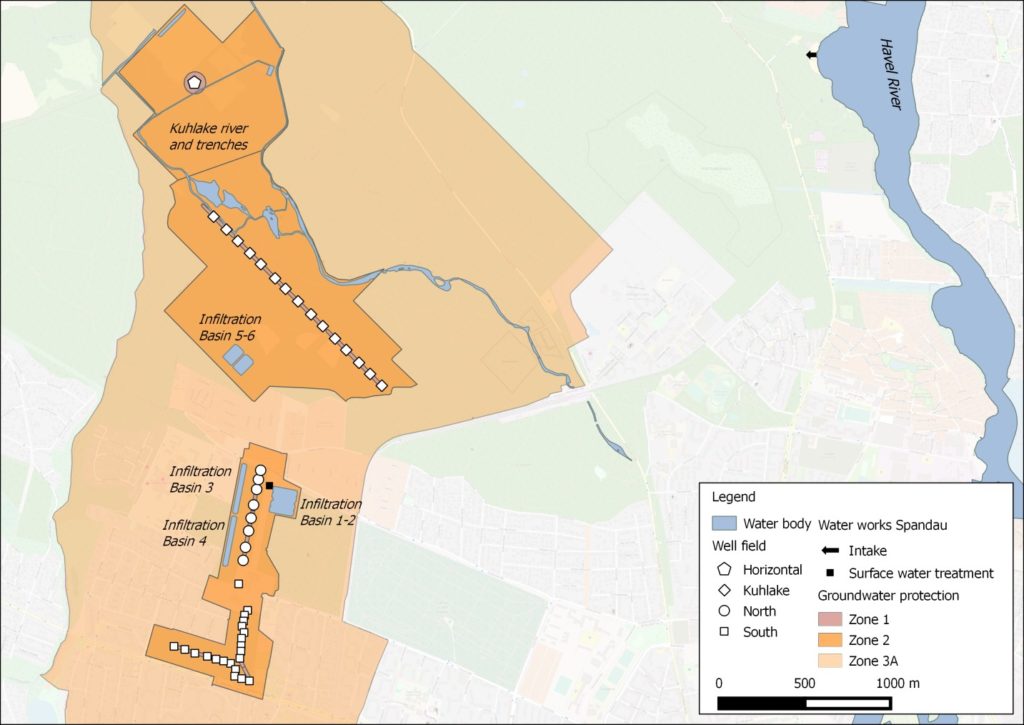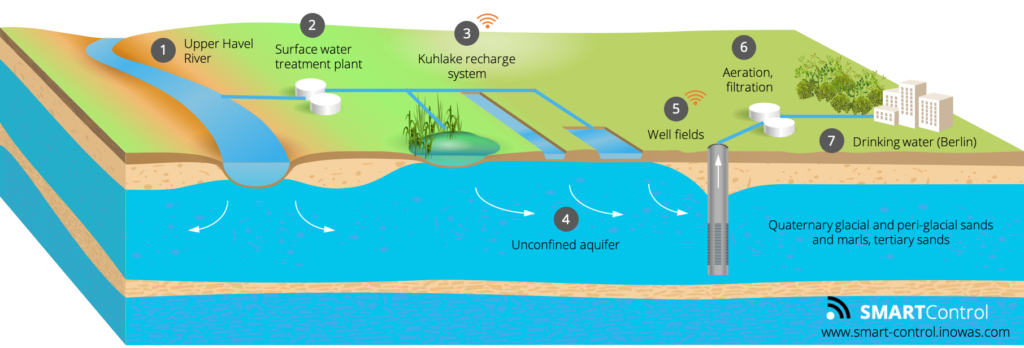The waterworks Berlin-Spandau is situated in the northwestern part of Berlin and was inaugurated in the year 1897. At the beginning, eight abstraction wells were drilled and the operational supply was in these early years about 5000 m3/d. Nowadays the delivered drinking water volume is about 25 to 30 Mm3/a (ca. 70,000 m3/d). Water source is entirely groundwater abstracted at four sites: i) one horizontal well, ii) well field Kuhlake, iii) well field north, and iv) well field south (Figure 1).

The source water for infiltration at the waterworks Berlin-Spandau is abstracted from the Upper Havel River and pre-treated in a Surface Water Treatment Plant (SWTP) by mechanical cleaning, flocculation and rapid sand filtration.The pre-treated water is then recharged to the groundwater through constructed infiltration basins and various lakes, trenches and ponds (Kuhlake). The technical pre-treatment aims at removing suspended solids and nutrients.
The catchment area of the WW Spandau consists of urbanized and forested areas with groundwater dependent ecosystems, e.g. in the Spandau forest in the north with swamps and wetlands. These groundwater dependent ecosystems are within the protection zones (Zone 2 and 3) of the WW and are hydraulically supported by the water inflow into the Kuhlake system. Natural groundwater recharge does not cover the water demand. Therefore, groundwater is augmented by artificial recharge through engineered infiltration basins, lakes and trenches. The infiltration basins, artificial lakes and trenches are supplied by surface water from the Havel River in the range of 20 Mm3/a.
The constructed infiltration basins have an infiltration area of approx. 54,000 m2 and show infiltration rates of up to 3.4 m/d with large variation due to geometry and hydraulic properties of the subsurface. The Kuhlake system consists of 137,000 m2 of water area, of which approx. 59,000 m2 are rivers/ponds and 78,000 m2 are trenches. In contrast to the constructed infiltration basins, the Kuhlake system is not maintained (e.g. cleaning) on a regular basis. Infiltration rates are therefore one order of magnitude lower. However, the recharge water percolates through the soil (Kuhlake) and/or the unsaturated zone of the aquifer and reaches the free water table. The aquifer itself consists of fluvial-glacial sand and marl deposits of quaternary to tertiary age. The water is recovered by 44 vertical wells and 1 horizontal well. The recovered water is aerated to precipitate dissolved iron/manganese and subsequently filtered through rapid sand filters, before being distributed to the water net as drinking water (Figure 2 and Table 1).

Table 1: Components of the Berlin-Spandau MAR system.
| MAR component | Berlin-Spandau MAR site |
| 1. Capture zone | River Water (Upper Havel River) |
| 2. Pre-treatment | Shell flter, flocculation, rapid sand filtration |
| 3. Recharge | Wetlands, ditches, ponds, infiltration basins |
| 4. Subsurface | Quaternary glacial and peri-glacial sands and marls, tertiary sands |
| 5. Recovery | 3 well fields (44 vertical wells, 1 horizontal well) |
| 6. Post-treatment | Aeration, rapid sand filtration |
| 7. End use | Drinking water, ecosystem |
At this case study, the project will focus on real-time microbial risk assessment using an innovative, fully automated online flow cytometry system. The specific objective is to combine real-time monitoring of subsurface residence times with high-resolution microbial dynamics, both influenced by natural and operational events in a groundwater well used for drinking water production.